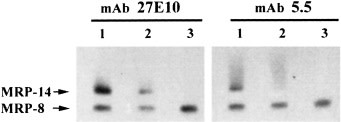Cat. #151056
Anti-S100A8 & S100A9 [5.5] mAb
Cat. #: 151056
Sub-type: Primary antibody
Unit size: 100 ug
Availability: 3-4 weeks
Target: S100A8 (MRP-8) & S100A9 (MRP-14)
Class: Monoclonal
Application: ELISA ; FACS ; IHC ; IP ; WB
Reactivity: Human
Host: Mouse
£300.00
This fee is applicable only for non-profit organisations. If you are a for-profit organisation or a researcher working on commercially-sponsored academic research, you will need to contact our licensing team for a commercial use license.
Contributor
Inventor: Nancy Hogg
Institute: Cancer Research UK, London Research Institute: Lincoln's Inn Fields
Tool Details
*FOR RESEARCH USE ONLY (for other uses, please contact the licensing team)
- Name: Anti-S100A8 & S100A9 [5.5] mAb
- Research fields: Cell biology;Genetics
- Clone: 5.5
- Tool sub type: Primary antibody
- Class: Monoclonal
- Conjugation: Unconjugated
- Molecular weight: 37 kDa
- Strain: Balb/c
- Reactivity: Human
- Host: Mouse
- Application: ELISA ; FACS ; IHC ; IP ; WB
- Description: S100A8 (MRP-8) and S100A9 (MRP-14) are cytosolic calcium-binding proteins of 8kDa and 14kDa that form a heterodimer. S100A8 and S100A9 are expressed in secretory and inflamed keratinocytes, peripheral blood monocytes, neutrophils and has been described in platelets, dendritic cells and some T cell types. Expression is lost on tissue maturation of monocytes to macrophages. S100A9 may be associated with monocyte and neutrophil activation and the accumulation of these cells in inflammatory sites.
- Immunogen: Acute monocytic leukaemia cells.
- Isotype: IgG1
- Myeloma used: Sp2/0-Ag14
- Recommended controls: This antibody was used to detect S100A8/S100A9 in neutrophil extracts (Hogg et al., 1989) This antibody was used to detect S100A8/S100A9 in Human monocyte and neutrophil extracts (Edgeworth et al., 1991)
Target Details
- Target: S100A8 (MRP-8) & S100A9 (MRP-14)
- Molecular weight: 37 kDa
- Tissue cell line specificity: This antibody was used to detect S100A8/S100A9 in neutrophil extracts (Hogg et al., 1989) This antibody was used to detect S100A8/S100A9 in Human monocyte and neutrophil extracts (Edgeworth et al., 1991)
- Target background: S100A8 (MRP-8) and S100A9 (MRP-14) are cytosolic calcium-binding proteins of 8kDa and 14kDa that form a heterodimer. S100A8 and S100A9 are expressed in secretory and inflamed keratinocytes, peripheral blood monocytes, neutrophils and has been described in platelets, dendritic cells and some T cell types. Expression is lost on tissue maturation of monocytes to macrophages. S100A9 may be associated with monocyte and neutrophil activation and the accumulation of these cells in inflammatory sites.
Applications
- Application: ELISA ; FACS ; IHC ; IP ; WB
Handling
- Format: Liquid
- Concentration: 1 mg/ml
- Unit size: 100 ug
- Storage buffer: PBS with 0.02% azide
- Storage conditions: -15° C to -25° C
- Shipping conditions: Shipping at 4° C
References
- Wen et al. 2018. Nat Med. 24(2):154-164. PMID: 29291352.
- Wang et al. 2014. J Clin Invest. 124(5):2160-71. PMID: 24691441.
- Ryckman et al. 2003. Arthritis Rheum. 48(8):2310-20. PMID: 12905486.
- Role of S100A8 and S100A9 in neutrophil recruitment in response to monosodium urate monohydrate crystals in the air-pouch model of acute gouty arthritis.
- Hessian et al. 2001. Eur J Biochem. 268(2):353-63. PMID: 11168370.
- Hessian et al. 2001. Eur J Biochem. 268(2):353-63. PMID: 11168370.
- The heterodimeric complex of MRP-8 (S100A8) and MRP-14 (S100A9). Antibody recognition, epitope definition and the implications for structure.
- Edgeworth et al. 1991. J Biol Chem. 266(12):7706-13. PMID: 2019594.
- Identification of p8,14 as a highly abundant heterodimeric calcium binding protein complex of myeloid cells.
- Hogg et al. 1989. Eur J Immunol. 19(6):1053-61. PMID: 2666142.
- Hogg et al. 1989. Eur J Immunol. 19(6):1053-61. PMID: 2666142.
- Monoclonal antibody 5.5 reacts with p8,14, a myeloid molecule associated with some vascular endothelium.



